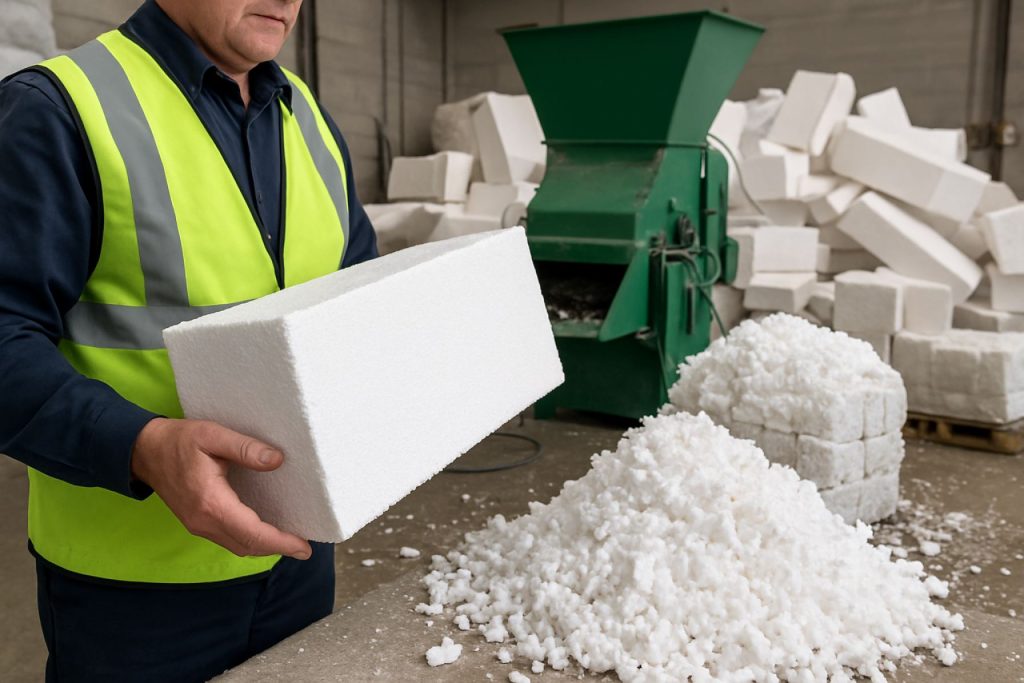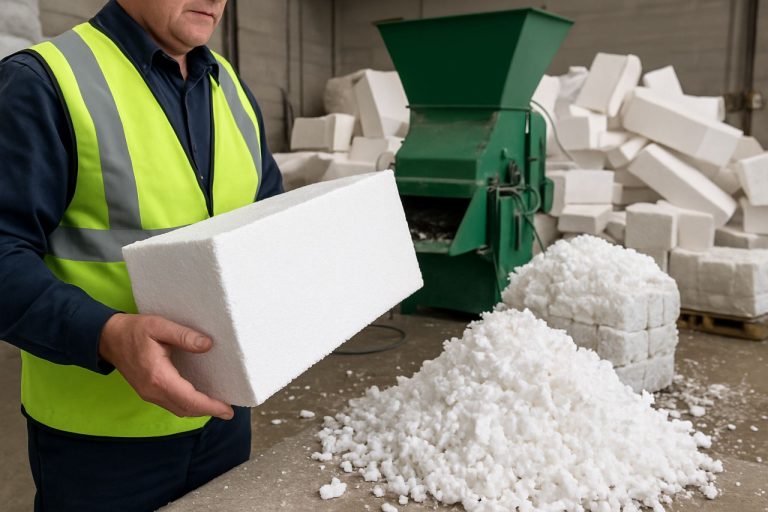
Expanded Polystyrene Recycling Technologies Market Report 2025: In-Depth Analysis of Growth Drivers, Innovations, and Global Opportunities. Explore Key Trends, Forecasts, and Strategic Insights for Industry Stakeholders.
- Executive Summary & Market Overview
- Key Market Drivers and Restraints
- Technology Trends in Expanded Polystyrene Recycling
- Competitive Landscape and Leading Players
- Market Size & Growth Forecasts (2025–2030)
- Regional Analysis: Market Dynamics by Geography
- Challenges and Barriers to Adoption
- Opportunities and Strategic Recommendations
- Future Outlook: Emerging Innovations and Policy Impacts
- Appendix: Data Sources and Methodology
- Sources & References
Executive Summary & Market Overview
Expanded polystyrene (EPS) recycling technologies are gaining significant traction in 2025, driven by mounting regulatory pressures, environmental concerns, and advancements in material recovery processes. EPS, commonly known as Styrofoam, is widely used in packaging, construction, and consumer goods, but its low density and bulky nature have historically posed challenges for efficient collection and recycling. As global plastic waste management policies tighten, the market for EPS recycling technologies is experiencing robust growth and innovation.
In 2025, the EPS recycling market is characterized by a mix of mechanical and chemical recycling solutions. Mechanical recycling, which involves shredding and compacting EPS into reusable pellets, remains the most established method, particularly in regions with mature waste collection infrastructure. However, chemical recycling technologies—such as dissolution, depolymerization, and pyrolysis—are rapidly emerging, offering the potential to convert EPS waste into high-value monomers or fuels. These advanced processes are attracting investment due to their ability to handle contaminated or mixed waste streams, which are common in post-consumer EPS applications.
According to Allied Market Research, the global EPS market is projected to reach $22.7 billion by 2027, with recycling technologies playing a pivotal role in supporting circular economy initiatives. Europe leads in regulatory-driven adoption, with the European Union’s Single-Use Plastics Directive accelerating the deployment of EPS recycling infrastructure. In North America, public-private partnerships and extended producer responsibility (EPR) schemes are fostering investment in both collection systems and advanced recycling plants. Meanwhile, Asia-Pacific is witnessing rapid growth, propelled by urbanization and increasing consumer awareness, though infrastructure gaps remain a challenge.
- Key players such as BASF, Styropor, and INTCO Recycling are expanding their portfolios to include both mechanical and chemical recycling solutions.
- Innovative startups are entering the market with proprietary solvent-based and enzymatic recycling technologies, aiming to improve yield and reduce energy consumption.
- Government incentives and stricter landfill bans on EPS are accelerating technology adoption, particularly in urban centers and coastal regions where EPS pollution is most acute.
Overall, the EPS recycling technology market in 2025 is marked by rapid innovation, increasing regulatory support, and a growing emphasis on scalable, economically viable solutions that can address the unique challenges of EPS waste management.
Key Market Drivers and Restraints
Expanded polystyrene (EPS) recycling technologies are gaining momentum in 2025, driven by a confluence of regulatory, economic, and environmental factors. One of the primary market drivers is the tightening of environmental regulations across major economies. The European Union’s Circular Economy Action Plan and similar initiatives in North America and Asia are mandating higher recycling rates and restricting landfill disposal of EPS, compelling manufacturers and waste management companies to invest in advanced recycling solutions (European Commission).
Corporate sustainability commitments are also accelerating the adoption of EPS recycling technologies. Major packaging and consumer goods companies are pledging to increase the recycled content in their products and reduce plastic waste, creating a robust demand for high-quality recycled EPS. This is further supported by growing consumer awareness and preference for sustainable packaging, which is pressuring brands to seek out recycled materials (United Nations Environment Programme).
Technological advancements are another significant driver. Innovations in mechanical and chemical recycling processes, such as dissolution and depolymerization, are improving the efficiency and economic viability of EPS recycling. These technologies enable the recovery of high-purity polystyrene from post-consumer and post-industrial waste streams, expanding the range of applications for recycled EPS (PlasticsEurope).
However, the market faces notable restraints. The collection and sorting of EPS waste remain challenging due to its low density and high volume, which increase transportation and handling costs. In many regions, the lack of dedicated infrastructure for EPS collection limits feedstock availability for recyclers. Additionally, contamination of EPS waste with food residues or other materials can reduce the quality of recycled output and increase processing costs (EPS Industry Alliance).
Economic factors also play a restraining role. Virgin polystyrene prices are often volatile and, at times, lower than the cost of recycled material, undermining the competitiveness of recycling operations. Furthermore, the fragmented nature of the EPS recycling industry, with many small-scale operators, can hinder the development of standardized processes and large-scale investments (MarketsandMarkets).
In summary, while regulatory pressure, corporate sustainability goals, and technological innovation are propelling the EPS recycling technologies market forward in 2025, logistical, economic, and quality-related challenges continue to restrain its full-scale adoption.
Technology Trends in Expanded Polystyrene Recycling
Expanded polystyrene (EPS) recycling technologies are evolving rapidly in response to mounting environmental concerns and regulatory pressures. As of 2025, the industry is witnessing a shift from traditional mechanical recycling methods to more advanced chemical and hybrid processes, aiming to improve recovery rates and the quality of recycled material.
Mechanical Recycling remains the most widely adopted method, involving collection, cleaning, shredding, and reprocessing of EPS waste into pellets for use in new products. However, mechanical recycling is limited by contamination issues and the degradation of polymer properties, which restricts the range of applications for recycled EPS (Association of Plastic Recyclers).
Chemical Recycling technologies are gaining traction, particularly depolymerization and dissolution processes. Depolymerization breaks EPS down into its monomer, styrene, which can be repolymerized into virgin-quality polystyrene. Companies such as Agilyx and Polystyvert are pioneering these methods, with commercial-scale plants demonstrating the ability to handle contaminated and mixed EPS waste streams. Dissolution technologies, which use solvents to dissolve EPS and recover it for reuse, are also being scaled up, offering a lower-energy alternative to depolymerization (Eunomia Research & Consulting).
Hybrid Approaches are emerging, combining mechanical and chemical steps to maximize recovery and minimize environmental impact. For example, pre-treatment via mechanical shredding followed by chemical purification can enhance the efficiency and output quality of recycling plants (PlasticsEurope).
- Digitalization and AI: Advanced sorting technologies using artificial intelligence and robotics are improving the identification and separation of EPS from mixed waste streams, increasing the purity and yield of recycled material (TOMRA).
- Decentralized Recycling: Compact, modular recycling units are being deployed closer to waste generation points, reducing transportation costs and emissions (Technavio).
- Closed-Loop Systems: Partnerships between EPS producers and recyclers are fostering closed-loop supply chains, where recycled EPS is directly reintegrated into new packaging and construction products (EPS Industry Alliance).
In summary, 2025 marks a pivotal year for EPS recycling technologies, with chemical and hybrid methods poised to complement and, in some cases, surpass traditional mechanical recycling in efficiency and sustainability.
Competitive Landscape and Leading Players
The competitive landscape for expanded polystyrene (EPS) recycling technologies in 2025 is characterized by a mix of established chemical companies, innovative startups, and collaborative industry initiatives. The market is driven by increasing regulatory pressure to reduce plastic waste, growing consumer demand for sustainable packaging, and advancements in recycling processes. Key players are focusing on both mechanical and chemical recycling methods, with a notable shift toward scalable, closed-loop solutions.
Among the leading players, BASF has made significant investments in chemical recycling, particularly through its ChemCycling™ project, which converts post-consumer EPS waste into new raw materials for high-quality plastics. TotalEnergies is another major player, leveraging its advanced recycling technologies and partnerships with waste management firms to increase EPS recycling rates across Europe and North America.
On the mechanical recycling front, ALPLA Group and Styropor (a brand of BASF) have developed efficient collection and compaction systems, enabling the transformation of used EPS into new packaging and insulation products. These companies are also collaborating with local governments and retailers to establish take-back schemes and improve feedstock quality.
Innovative startups such as Polystyvert are gaining traction with proprietary dissolution-based recycling technologies, which allow for the purification and reuse of EPS with minimal degradation of material properties. Greenmax (a division of INTCO Recycling) is recognized for its global network of EPS densification and recycling facilities, serving both municipal and commercial clients.
Industry alliances, such as the EPS Industry Alliance and Circularise, are playing a pivotal role in standardizing recycling protocols, promoting traceability, and fostering cross-sector collaboration. These organizations are instrumental in driving policy advocacy and public awareness, further shaping the competitive dynamics of the sector.
Overall, the EPS recycling technology market in 2025 is marked by rapid innovation, strategic partnerships, and a clear trend toward circular economy models. Companies that can demonstrate both technological scalability and environmental impact are poised to lead as regulatory and consumer expectations continue to rise.
Market Size & Growth Forecasts (2025–2030)
The global market for expanded polystyrene (EPS) recycling technologies is poised for significant growth between 2025 and 2030, driven by tightening environmental regulations, increasing consumer awareness, and advancements in recycling processes. In 2025, the market size for EPS recycling technologies is estimated to reach approximately USD 1.2 billion, with a projected compound annual growth rate (CAGR) of 8.5% through 2030, according to MarketsandMarkets. This robust growth is underpinned by the rising demand for sustainable packaging solutions and the proliferation of circular economy initiatives across major economies.
Europe is expected to maintain its lead in the adoption of EPS recycling technologies, accounting for over 35% of the global market share in 2025. This dominance is attributed to stringent EU directives on plastic waste and the implementation of extended producer responsibility (EPR) schemes, as highlighted by Plastics Recyclers Europe. North America and Asia-Pacific are also witnessing accelerated investments, with China and Japan emerging as key markets due to government-backed recycling mandates and growing industrial applications of recycled EPS.
Technological innovation is a critical growth driver. Mechanical recycling remains the most widely adopted method, but chemical recycling technologies—such as dissolution and depolymerization—are gaining traction for their ability to process contaminated or mixed EPS waste streams. According to Allied Market Research, the chemical recycling segment is forecasted to grow at a CAGR exceeding 10% during the forecast period, outpacing traditional mechanical methods.
- By 2030, the global EPS recycling technologies market is projected to surpass USD 1.8 billion in value.
- Packaging and construction sectors will remain the largest end-users, collectively accounting for over 60% of recycled EPS demand.
- Emerging markets in Southeast Asia and Latin America are expected to register double-digit growth rates, fueled by urbanization and infrastructure development.
Overall, the period from 2025 to 2030 will be characterized by rapid market expansion, increased cross-sector collaboration, and a shift toward advanced recycling solutions, positioning EPS recycling technologies as a pivotal component of the global plastics circularity agenda.
Regional Analysis: Market Dynamics by Geography
The regional dynamics of expanded polystyrene (EPS) recycling technologies in 2025 are shaped by regulatory frameworks, infrastructure maturity, and market demand across key geographies. North America, Europe, and Asia-Pacific represent the most significant markets, each exhibiting distinct drivers and challenges.
North America continues to advance EPS recycling through a combination of public-private partnerships and investments in mechanical and chemical recycling technologies. The United States, in particular, has seen increased adoption of advanced depolymerization and solvent-based processes, supported by state-level bans on single-use EPS and extended producer responsibility (EPR) initiatives. Companies such as Dart Container Corporation and Agilyx are leading efforts to scale up chemical recycling, with several pilot plants operational or in development. However, collection infrastructure remains fragmented, limiting feedstock availability in some regions.
Europe is at the forefront of EPS recycling, driven by stringent EU directives on packaging waste and circular economy targets. The region has witnessed robust growth in both mechanical recycling and innovative chemical recycling projects, with organizations like EPS Industry Alliance and Synbra investing in closed-loop systems. Germany, the Netherlands, and France are leading in collection rates and recycling capacity, aided by harmonized waste management policies and consumer awareness campaigns. The European Green Deal and the Single-Use Plastics Directive are expected to further accelerate technology adoption and cross-border collaboration in 2025.
- Asia-Pacific is characterized by rapid urbanization and high EPS consumption, particularly in China, Japan, and South Korea. China’s ban on certain EPS packaging has spurred investment in alternative materials and advanced recycling technologies, including pyrolysis and supercritical fluid processes. Japanese firms such as Mitsui Chemicals are pioneering solvent-based recycling, while South Korea is expanding its EPS collection network. However, inconsistent regulatory enforcement and limited infrastructure in emerging economies pose ongoing challenges.
Other regions, including Latin America and the Middle East, are in earlier stages of EPS recycling adoption, with pilot projects and policy frameworks under development. Overall, the global landscape in 2025 reflects a shift toward integrated recycling solutions, with regional leaders setting benchmarks for technology deployment and circularity in the EPS value chain.
Challenges and Barriers to Adoption
The adoption of expanded polystyrene (EPS) recycling technologies faces several persistent challenges and barriers, despite growing regulatory and consumer pressure to address plastic waste. One of the primary obstacles is the economic viability of recycling EPS. Due to its low density and high volume-to-weight ratio, transporting collected EPS to recycling facilities is often cost-prohibitive, especially in regions lacking local processing infrastructure. This logistical challenge is compounded by the fact that EPS is frequently contaminated with food residues or mixed with other materials, which increases the cost and complexity of sorting and cleaning prior to recycling Association of Plastic Recyclers.
Technological limitations also hinder widespread adoption. While mechanical recycling methods, such as compacting and pelletizing, are established, they often result in downcycled products with limited market value. Advanced chemical recycling technologies, which can break EPS down into its monomeric components for higher-value reuse, remain in the pilot or early commercialization stages and are not yet widely available at scale. These processes can be energy-intensive and require significant capital investment, further deterring adoption by recyclers and municipalities Eunomia Research & Consulting.
Regulatory inconsistencies across regions also create uncertainty for stakeholders. While some jurisdictions have implemented bans or strict regulations on EPS packaging, others lack clear mandates or incentives for recycling. This patchwork of policies complicates investment decisions and the development of standardized collection and recycling systems EPS Industry Alliance.
Consumer participation is another critical barrier. Public awareness of EPS recyclability remains low, and many consumers are unaware of local collection programs or drop-off locations. As a result, a significant portion of EPS waste continues to be landfilled or incinerated rather than recycled. Efforts to improve labeling, education, and convenient collection infrastructure are ongoing but have yet to achieve widespread behavioral change Plastics Recycling Update.
In summary, the main challenges to the adoption of EPS recycling technologies in 2025 include economic and logistical hurdles, technological limitations, regulatory fragmentation, and low consumer engagement. Overcoming these barriers will require coordinated efforts from industry, policymakers, and the public to create a more viable and scalable EPS recycling ecosystem.
Opportunities and Strategic Recommendations
The landscape for expanded polystyrene (EPS) recycling technologies in 2025 is shaped by mounting regulatory pressures, evolving consumer preferences, and significant technological advancements. As governments worldwide intensify restrictions on single-use plastics and landfill disposal, the demand for sustainable EPS management solutions is accelerating. This creates substantial opportunities for stakeholders across the value chain, from recyclers and technology providers to packaging manufacturers and brand owners.
Key opportunities lie in the development and deployment of advanced recycling technologies. Mechanical recycling remains the most established method, but its limitations—such as contamination sensitivity and downcycling—are driving interest in alternative approaches. Chemical recycling, particularly depolymerization and dissolution processes, is gaining traction for its ability to convert EPS waste into high-purity styrene monomers or other valuable products, enabling true circularity. Companies investing in scalable chemical recycling infrastructure are well-positioned to capture market share as these technologies mature and regulatory frameworks evolve to recognize their outputs as recycled content. For example, BASF and TotalEnergies have both announced pilot projects and partnerships focused on chemical recycling of polystyrene.
Strategic recommendations for market participants include:
- Invest in R&D and Partnerships: Collaborate with technology innovators and research institutions to accelerate the commercialization of advanced recycling methods. Joint ventures can help share risks and pool expertise, as seen in the INEOS and Agilyx partnership for polystyrene chemical recycling.
- Engage with Policymakers: Proactively participate in policy dialogues to shape favorable regulatory environments, such as the recognition of chemical recycling outputs in recycled content mandates. Engagement with organizations like the EPS Industry Alliance can amplify industry voices.
- Expand Collection Infrastructure: Invest in or support the development of efficient EPS collection and sorting systems, leveraging digital tracking and reverse logistics to increase feedstock availability and quality.
- Promote Circular Economy Solutions: Develop closed-loop programs with downstream users, such as appliance and packaging manufacturers, to secure offtake agreements for recycled EPS and demonstrate environmental benefits to end customers.
In summary, the EPS recycling sector in 2025 offers robust growth prospects for companies that embrace innovation, foster cross-sector collaboration, and align with the global shift toward circularity and sustainability. Early movers in advanced recycling technologies and integrated value chain solutions are likely to secure competitive advantages as the market matures.
Future Outlook: Emerging Innovations and Policy Impacts
The future outlook for expanded polystyrene (EPS) recycling technologies in 2025 is shaped by a convergence of technological innovation and evolving policy frameworks. As global pressure mounts to address plastic waste, the EPS recycling sector is witnessing accelerated investment in advanced recycling methods, including chemical recycling, dissolution, and enhanced mechanical processes. These innovations are designed to overcome the traditional challenges of EPS recycling, such as contamination, low density, and high transportation costs.
Chemical recycling, particularly depolymerization, is gaining traction as a promising solution for converting EPS waste back into its monomer, styrene, which can then be reused in new products. Companies like Agilyx are scaling up commercial operations that leverage this technology, with pilot projects demonstrating the ability to process contaminated and mixed EPS streams. Similarly, dissolution technologies, which use solvents to break down EPS for purification and reformation, are being piloted in Europe and Asia, offering a route to high-purity recycled material.
On the policy front, 2025 is expected to see the implementation of stricter extended producer responsibility (EPR) schemes and landfill bans for EPS in several regions, particularly within the European Union. The European Commission is driving regulatory changes that incentivize the use of recycled content and penalize single-use plastics, directly impacting EPS packaging and foodservice applications. In the United States, states like California and New York are considering or enacting legislation to restrict EPS use and mandate recycling targets, further stimulating demand for advanced recycling solutions.
- Investment in EPS recycling infrastructure is projected to grow, with the global EPS recycling market expected to reach $1.2 billion by 2025, according to MarketsandMarkets.
- Collaborative initiatives, such as the EPS Industry Circularity Platform, are fostering data transparency and traceability, which are critical for scaling closed-loop recycling systems.
- Emerging digital tools, including AI-driven sorting and blockchain-based tracking, are expected to enhance collection efficiency and material quality, supporting higher recycling rates.
In summary, 2025 will likely mark a pivotal year for EPS recycling, as technological breakthroughs and policy mandates converge to drive higher recovery rates, improved material quality, and greater circularity in the EPS value chain.
Appendix: Data Sources and Methodology
This appendix details the data sources and methodology used in the analysis of expanded polystyrene (EPS) recycling technologies for the year 2025. The research draws on a combination of primary and secondary data, industry reports, and direct communications with key stakeholders in the EPS recycling value chain.
Primary data was collected through interviews and surveys with representatives from leading EPS recycling technology providers, waste management companies, and industry associations. Notable contributors include Styrenics Circular Solutions, Agilyx, and INTCO Recycling. These organizations provided insights into the latest advancements in mechanical and chemical recycling, as well as operational data on plant capacities, input material quality, and output yields.
Secondary data sources comprised market research reports, government publications, and academic studies. Key references include the EPS Industry Alliance annual recycling reports, the European Environment Agency waste management statistics, and the Association of Plastic Recyclers technical guidelines. These sources provided quantitative data on EPS waste generation, collection rates, and recycling volumes at regional and global levels.
The methodology involved triangulating data from these sources to estimate the market size, technology adoption rates, and efficiency metrics for EPS recycling in 2025. Where discrepancies existed between sources, priority was given to the most recent and directly sourced industry data. Market sizing was further validated using financial disclosures and press releases from major EPS recyclers, such as Versalis and BASF.
Technological assessments were based on published case studies, patent filings, and pilot project results, with a focus on distinguishing between established mechanical recycling (e.g., compaction, re-pelletizing) and emerging chemical recycling methods (e.g., depolymerization, dissolution). Environmental impact data was sourced from life cycle assessments published by OECD and peer-reviewed journals.
- All monetary values are reported in USD and adjusted for inflation to 2025 values.
- Data cut-off for this analysis was March 2025.
- Where possible, data was cross-checked with third-party audits and independent market analyses.
Sources & References
- Allied Market Research
- BASF
- Styropor
- European Commission
- United Nations Environment Programme
- PlasticsEurope
- MarketsandMarkets
- Association of Plastic Recyclers
- Agilyx
- Polystyvert
- Eunomia Research & Consulting
- Technavio
- TotalEnergies
- Styropor
- Greenmax
- Circularise
- Plastics Recyclers Europe
- Dart Container Corporation
- INEOS
- Styrenics Circular Solutions
- European Environment Agency



